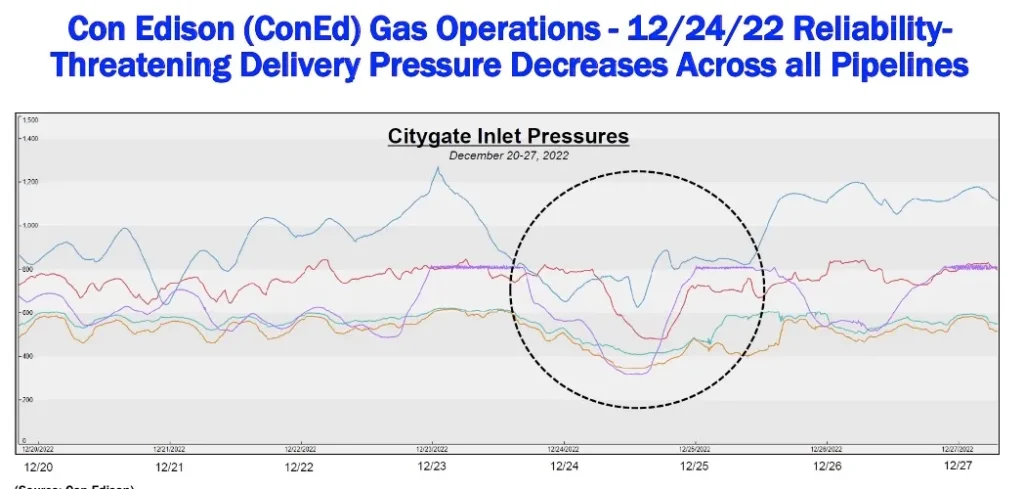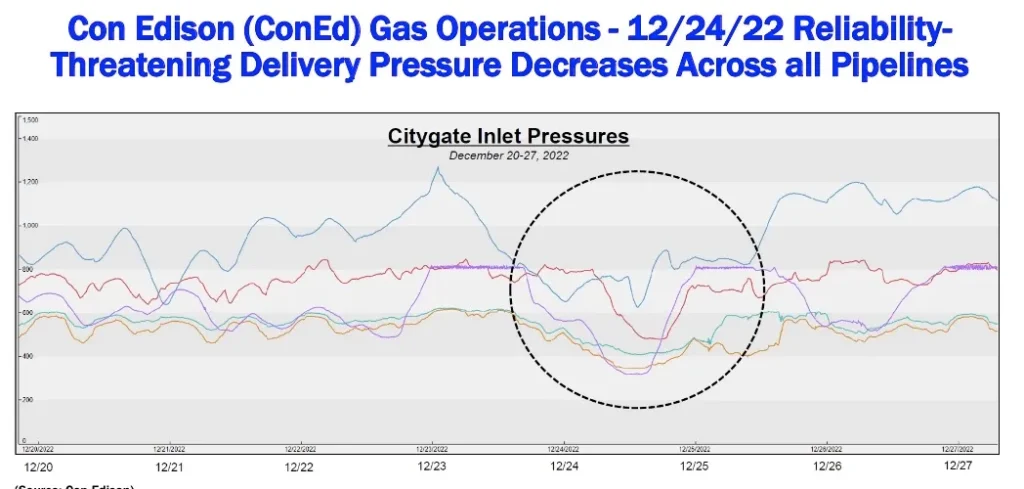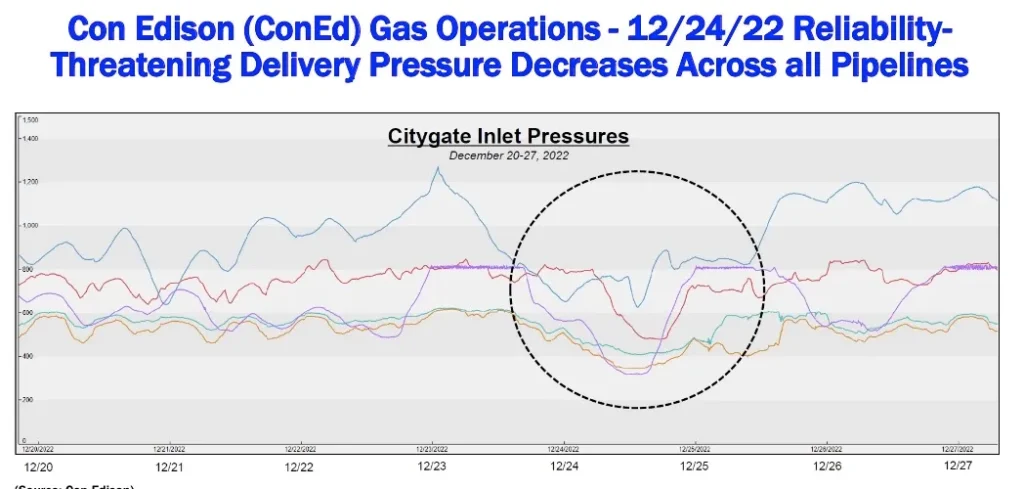https://robertbryce.substack.com/p/bone-chilling
By Robert Bryce
Winter Storm Elliott over the East Coast of the U.S., December 23, 2022. Credit: Wikipedia.
Chris Keefer, the Toronto-based physician and founder of Canadians for Nuclear Energy, calls the electric grid a “civilizational life support system.”
Keefer, of course, is correct. The most critical systems in our society — medical, water, wastewater, traffic lights, telecommunications, and lighting — depend on reliable electricity. But earlier this month, the Federal Energy Regulatory Commission and the North American Electric Reliability Corporation issued their final report on a winter storm that hammered the northeastern U.S. last year. And that report proves that our natural gas grid is just as essential as our electric grid. Indeed, FERC and NERC have repeatedly said that the two grids are intertwined, interdependent, and irreplaceable. Indeed, a reliable and resilient natural gas grid is critical to our energy security, and therefore, our national security.
Put short, policymakers ignore the importance of the gas pipeline system at our extreme peril.
In bone-dry language, the report “Inquiry into Bulk-Power System Operations During December 2022 Winter Storm Elliott,” explains how the gas pipeline network in New York nearly failed last Christmas when temperatures plummeted during the bomb cyclone. Freeze-related production declines, combined with soaring demand from power plants, homes, and businesses, led to shortages of gas throughout the Northeast. The lack of gas, as well as mechanical and electrical issues, resulted in an “unprecedented” loss of electric generation capacity totaling some 90,000 megawatts. While the lack of electricity was dangerous, the possibility of a loss of pressure in the natural gas network should send a bone-chilling shiver through the sacroiliac of every politician and bureaucrat in Washington, D.C., New York and the Northeast.
The report explains that if the gas pipeline system had failed, the recovery process in New York City would have taken “months.” In addition, the property damage due to damaged water pipes in homes and buildings would likely have caused hundreds of millions of dollars in damage.
Left unsaid in the report is that the collapse of the gas grid during the period in which temperatures in New York City stayed below freezing would have caused a calamity unlike any other in U.S. history. The cold that lasted from December 23 to December 28 could have resulted in thousands, or even tens of thousands, of deaths. The damage from burst water pipes would have rendered untold numbers of residential and office buildings in New York City unusable.
A friend who works for the federal government in Washington, D.C., and is familiar with the FERC/NERC report told me last week that the loss of gas in New York City would have required evacuating most of the people in the city. Let that soak in for a minute. New York City has roughly 8.5 million residents. Evacuating even 25% of Gotham’s residents during extreme cold would have required a herculean effort. But even assuming such an evacuation could be accomplished, imagine how the country would handle 2 million displaced New Yorkers who could not return to their homes for months. And while you’re at it, imagine if those 2 million New Yorkers had their homes soaked by broken water pipes.
In short, the U.S. narrowly averted both a humanitarian and economic crisis that could have put the country’s economy into a tailspin. Imagine America’s financial capital in such disarray that money center banks and Wall Street could not function because their office buildings didn’t have heat.
Here’s the critical section of the report, which explains that Winter Storm Elliott “greatly impacted the operations” of Consolidated Edison, the electric and gas utility that serves much of New York City. It continues:
On Christmas Eve morning, the five interstate natural gas pipelines serving Con Edison began experiencing drops in pressure at Con Edison’s citygate due to production losses and operational issues. The pressures declined precipitously and at noon, the pipelines informed Con Edison that they had exhausted their line pack and storage withdrawals, and pressures would not improve until demand decreased… Had Con Edison’s citygate pressures not recovered, it was in danger of losing pressure on, or needing to cut service to, all or large portions of its system. Even losing service to 130,000 customers would be considered a major outage and could have taken five to seven weeks to restore, depending on the availability of mutual aid. Had it lost the majority of its system, over a million customers in New York City and nearby areas would have been unable to heat their apartments and houses while the outside temperature was in the single digits…”
Slide from a FERC/NERC September 21, 2023 presentation showing gas pipeline pressure in New York City during Winter Storm Elliott.
The report also provides a good explanation for why restoring gas service is so complicated:
System outages for a local natural gas distribution company generally take longer to restore than firm load shed, or even cascading outages, on the electric grid. Once electricity is restored to a circuit, all of the homes can return to their normal functioning— lights turn back on, heating or air conditioning systems return to normal function, etc. By contrast, for the natural gas local distribution system to return system outages to normal operation, workers must go house-to-house and individually light every pilot light. Con Edison estimated it would have taken months to restore service, even with mutual assistance from other utilities, had it experienced a complete loss of its system.
A recent gas outage in the Pacific Northwest demonstrates the challenge of restoring service. On November 8, a gas transmission pipeline near Pullman, Washington, was damaged in an accident. The accident resulted in a shut off of gas to about 35,000 customers served by Avista Corp. Due to the loss of line pressure, the company had to dispatch a crew to every gas customer in the affected areas of their gas network and manually shut off each meter. After the pipeline was repaired, the utility deployed over 800 Avista employees, along with 300 workers from other gas utilities (who were responding under mutual-aid agreements) and about 60 private contractors, to begin the process of turning the gas system back on and relighting pilot lights on stoves and water heaters. It took nearly a week for the utility to restore service to the affected customers.
If it took a week to restore service to 35,000 gas customers in Washington state, it’s easy to understand how challenging it would be to restore service in a city as big and complex as New York. Con Edison has 1.1 million gas customers in Manhattan, the Bronx, Queens, and Westchester County. Put another way, Con Ed’s gas system is about 240 times as large as Avista’s. Even with a crew of 10,000 workers, it could take months to restore New York’s gas system if it failed.
Slide from a FERC/NERC September 21, 2023 presentation showing weather-related generation outages over the past decade.
It appears policymakers have been numbed into complacency about large generation outages and near-catastrophic misses over the past decade that include events like Winter Storms Uri and Elliott. But this latest near-catastrophe must be put into context. As mentioned above, NERC and FERC have repeatedly warned that the electric grid has become too dependent on natural gas. I love natural gas. And the increased use of gas (at the expense of coal) in the power sector has helped the U.S. cut its carbon dioxide emissions more than any other country in the world. But unlike coal — and the enriched uranium that fuels a nuclear power plant— gas is a just-in-time fuel. That makes it vulnerable to disruptions in service. And if gas supplies run short, so will electricity supplies.
In August, NERC again warned about the overreliance on natural gas, saying that gas and electricity markets “are significantly out of synchronism.” It continued, saying, “Natural gas access is further challenged by multiple priority uses, including home heating and industrial processes. Coordination should focus on…the challenges electric generators face in accessing natural gas during critical periods, such as severe winter weather events.” It also said the grid is increasingly vulnerable to “long duration temperatures as well as wind and solar droughts.”
In September, Jim Robb, the CEO of NERC, commented on a preliminary finding about Winter Storm Elliott, saying it “underscores the need to take urgent action on the interdependence between the bulk electric and natural gas systems, including the need for sufficient and reliable gas and electric infrastructure to sustain energy reliability.”
The other key backdrop to this report, of course, is the headlong rush to shutter coal-fired power plants, a push that is being funded, in part, by billionaire media mogul Michael Bloomberg. As I reported here last month, Bloomberg is giving another $500 million to a group of NGOs who are diligently working to:
shutter the bulk of our most important power plants — the ones that burn coal and natural gas and are therefore dispatchable and weather-resilient — and, in Bloomberg’s words, replace them with “renewable energy.”… A more radical agenda is difficult to conjure. The coal and gas plants that Bloomberg and his allies in the anti-industry industry want to shutter produced about 40% of all the electricity used in the U.S. last year.
In all, Bloomberg has committed more than $1 billion to a group of radical NGOs — including the League of Conservation Voters, Sierra Club, Rocky Mountain Institute, and Earthjustice, all of which have operating budgets of more than $100 million per year — who are aiming to undermine the integrity, affordability, and resilience of our electric grid.
The other essential bit of context is a recent statement by PJM Interconnection, the nation’s largest grid operator, that the premature shutdown of Maryland’s largest coal plant, Brandon Shores, will hurt grid reliability. As Fox News Digital reported earlier this week, an analysis by PJM “showed that the deactivation of the Brandon Shores units would cause severe voltage drop and thermal violations across seven PJM zones, which could lead to a widespread reliability risk in Baltimore and the immediate surrounding areas.”
Why is Brandon Shores closing? The short answer: in 2020, the plant’s owner, Talen Energy, agreed to shutter it as part of a deal it made with, wait for it…the Sierra Club.
The punchline here is obvious: America’s critical energy networks are nearing catastrophic breaking points due to underinvestment in reliable sources of fuel and generation, and by that, I mean pipelines, nuclear plants, and coal- and gas-fired power plants. As my friend in Washington told me last week, the energy sector doesn’t need more regulation; “it needs more infrastructure.” But the northeastern U.S. doesn’t have enough gas pipelines to meet demand during extreme weather. That’s particularly true in the wake of the closure of the Indian Point nuclear plant in New York. The output of that plant was replaced by gas-fired power plants.
Despite the need for more gas, over the past few years, four major interstate pipelines, with a total of 931 miles of pipe, have been blocked in New York by climate activist groups including 350.org. Those groups found a willing ally in the state’s execrable former governor, Andrew Cuomo.
A final point: On November 8, NERC released its 2023-2024 “Winter Reliability Assessment.” As noted by Reuters, the report found that “more than half of the U.S. and parts of Canada…could fall short of electricity during extreme cold again this winter due to lacking natural gas infrastructure.” The report also noted, “Recent extreme cold weather events have shown that energy delivery disruptions can have devastating consequences for electric and gas consumers in impacted areas.”
We’ve been warned. In fact, we’ve repeatedly been warned by both FERC and NERC that we don’t have enough gas pipelines and that our electric grid is relying too heavily on natural gas-fired power plants and weather-dependent sources like wind and solar.
Policymakers should believe them and begin taking action before we have to evacuate New York City due to events like the bomb cyclone that struck last Christmas.






